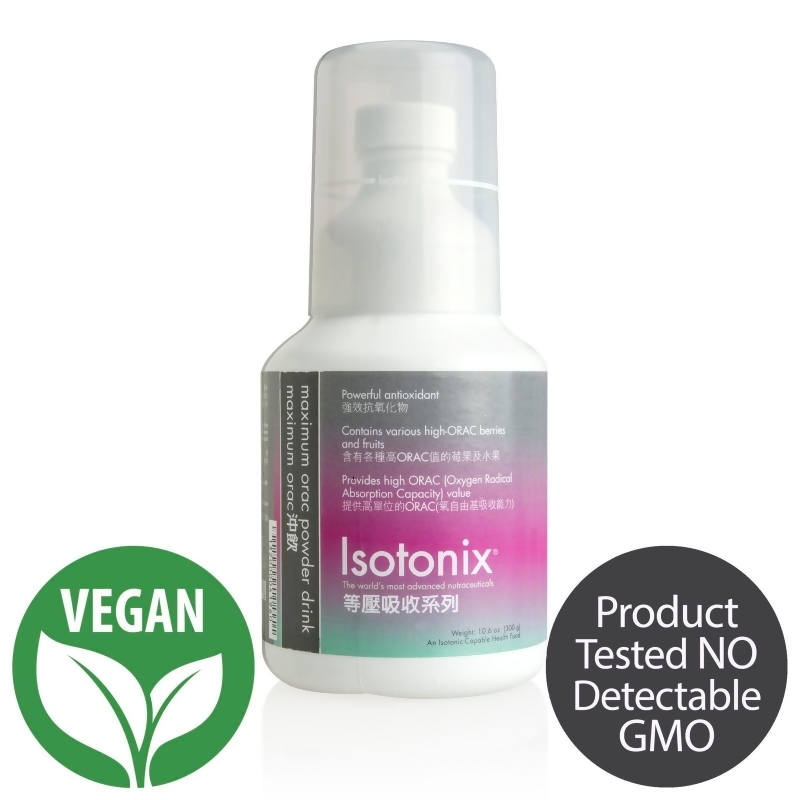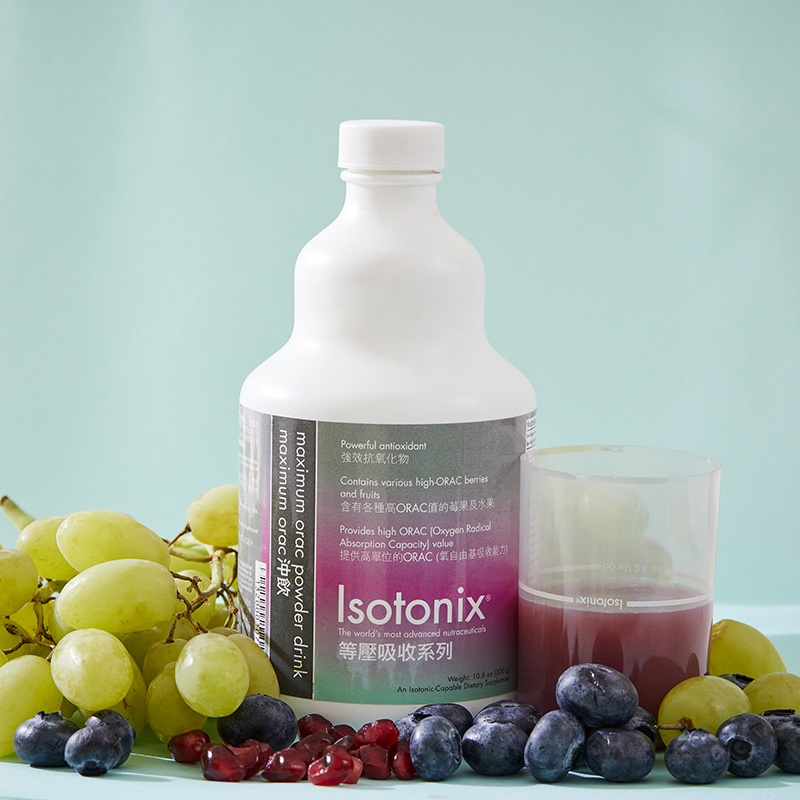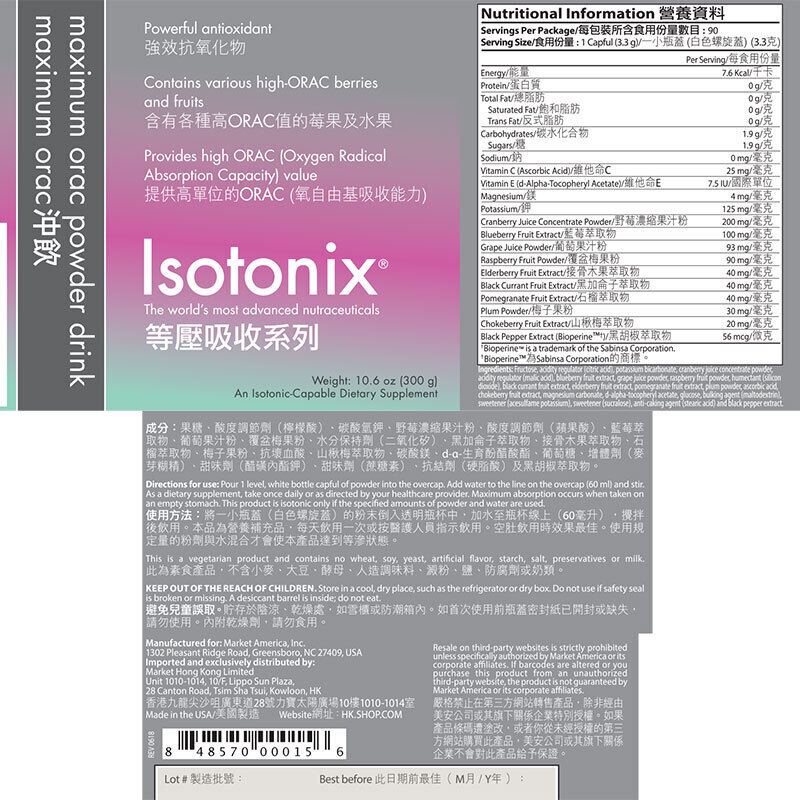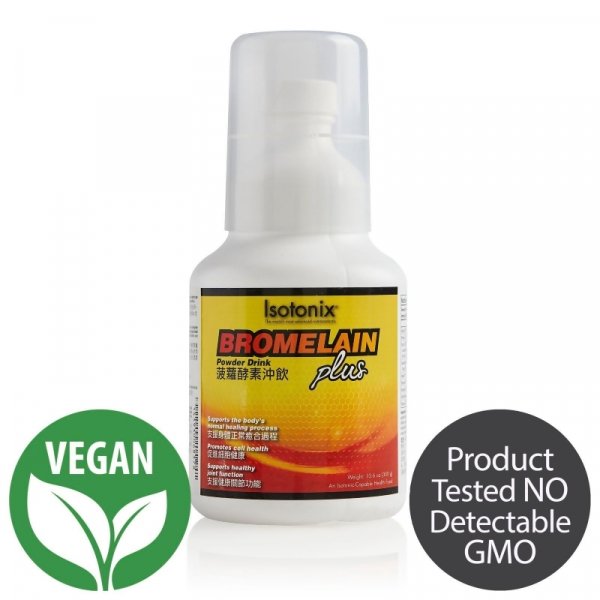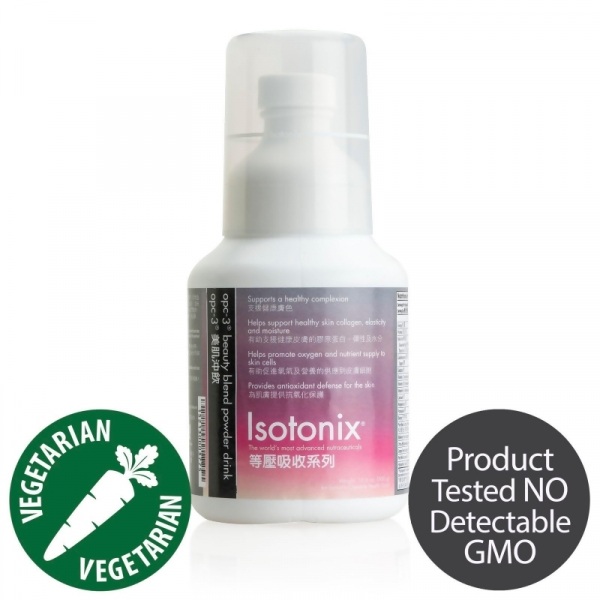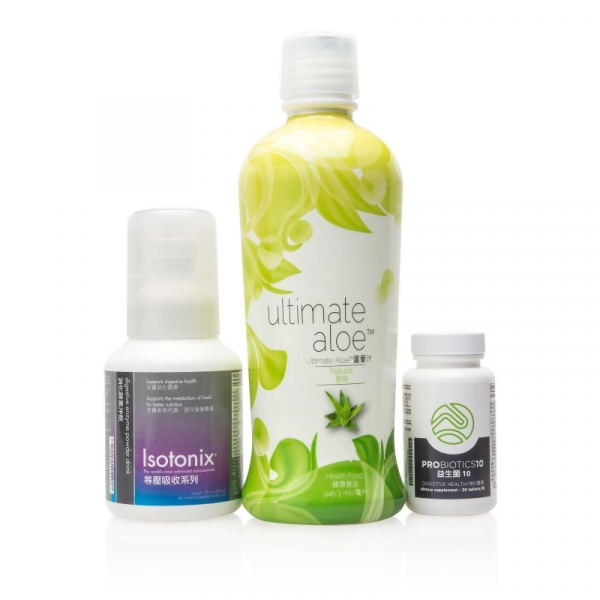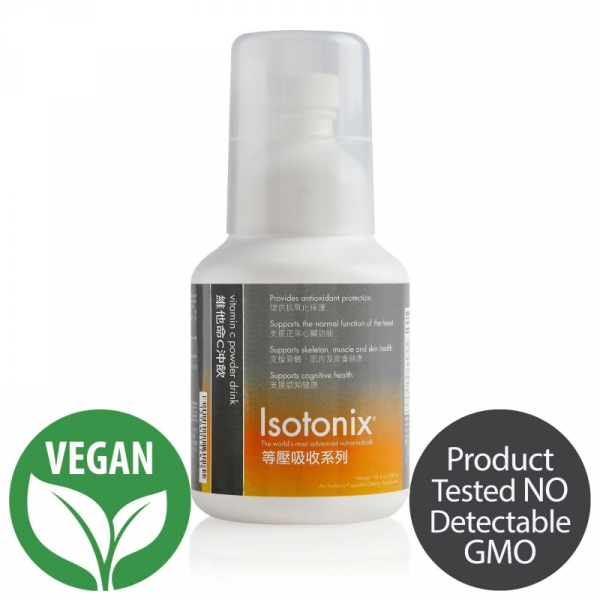Isotonix® Maximum ORAC 沖飲
$658.00
單瓶裝 (90份)
優良的ORAC營養補充品應含最少3000單位的ORAC值,而高ORAC值的食物有藍莓、小紅莓及接骨木莓等。
益處
- 全面的抗氧化防護網
- 清除自由基的強效抗氧化物
- 支援免疫系統健康
- 或有助穩定膽固醇*
- 高氧自由基吸收能力(ORAC)
- 胡椒素(Bioperine™)成份提高生物可利用性
- 支援認知能力健康
*此產品沒有根據《藥劑業及毒藥條例》或《中醫藥條例》註冊。為此產品作出的任何聲稱亦沒有為進行該等註冊而接受評核。此產品並不供作診斷、治療或預防任何疾病之用。
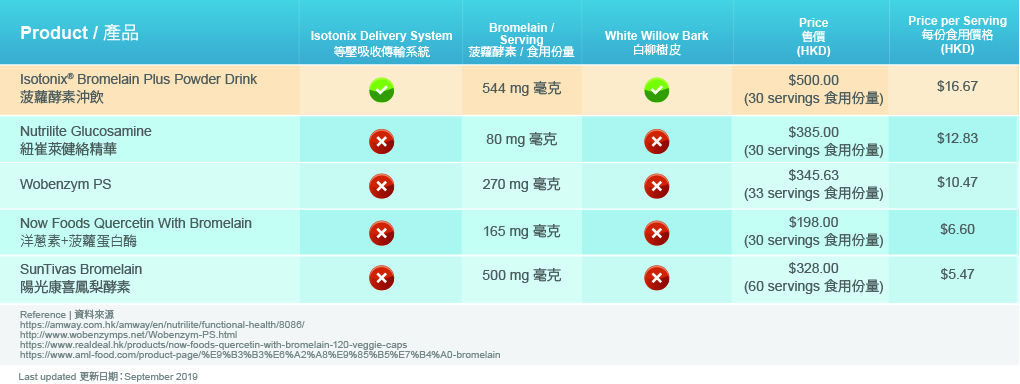
產品分類
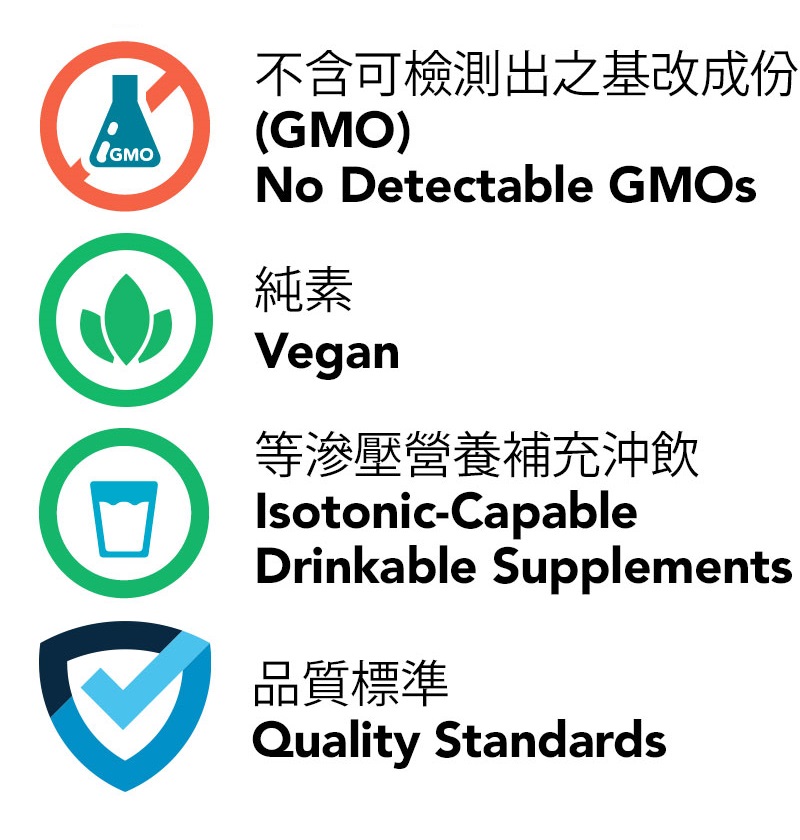
不含可檢測出之基改成份(GMO) – 本產品不含可檢測出之基因改造生物成份
純素 – 本產品不含動物相關成份
等滲壓營養補充沖飲 – 易於飲用的營養補充品 / 健康食品,透過等滲壓狀態達致更佳的營養吸收
品質標準 – 良好生產規範(GMP)運作與標準化成份
已檢測:重金屬丶微生物污染物丶過敏原丶效力丶純度及特性
詳細資料
優良的ORAC營養補充品應含最少3000單位的ORAC值,而高ORAC值的食物有藍莓、小紅莓及接骨木莓等。ORAC(Oxygen Radical Absorption Capacity)即氧自由基吸收能力,是一種衡量各種食物抗氧化能力及吸收氧自由基數量的標準。ORAC補充品採用天然維他命E及維他命C,可以在細胞內組成一個抗氧化防護網,比使用單一物質為人體提供更多保護。抗氧化物是天然的細胞守護者,透過將電子與最外層的氧自由基分子進行配對去中和自由基,令細胞變成無害。抗氧化物是能夠抗衡身體組織的氧化過程的營養素,例如維他命、礦物質及酵素等。抗氧化物以兩種方式運作︰斷鏈及預防。斷鏈的抗氧化物,如維他命A、C和E,能穩定自由基或使它轉化為無害的原子結構。
Isotonix Maximum ORAC 沖飲是一種等滲壓的營養補充品,含豐富的藍莓、覆盆子、蔓越莓、接骨木莓、黑加侖子、石榴、李子、維他命C和E(天然生育醇、生育三烯酚)和黑胡椒萃取物(Bioperine™¥)。胡椒素可提高某些營養素(尤其是抗氧化物)的生物可利用性,並促進小腸壁細胞的吸收。若要從食物中攝取3000單位的ORAC值,每天須進食 1 杯藍莓。美國疾病管制與預防中心(CDC)及美國國家癌症研究所(NCI)均建議每天食用 5-9 份水果及蔬菜。大多數人都很難做到這一點,因此食用營養補充品變得非常重要。一瓶蓋的Isotonix Maximum ORAC沖飲中就含有3000單位的ORAC值。Isotonix Maximum ORAC沖飲的功效在於其獨特的抗氧化特性。*
等滲壓代表「相同壓力」,與人體中的血液、血漿和淚水具有相同的化學特性。人體所有體液均具有若干濃度,稱為滲透壓。人體普遍的滲透壓,即等滲壓,令人體組織維持穩定的狀態。若要某種物質被人體吸收並用於新陳代謝,就必須以等滲壓的形態輸送。
Isotonix 營養補充品以等滲溶液輸送,這意味著身體可以輕鬆吸收最多的營養。溶液的等滲壓形態讓營養可以直達小腸,並迅速吸收至血液當中。Isotonix產品的營養流失量微乎其微,帶來極高效的吸收,提供最理想旳效果。
¥Bioperine™ 是Sabinsa Corporation的商標。
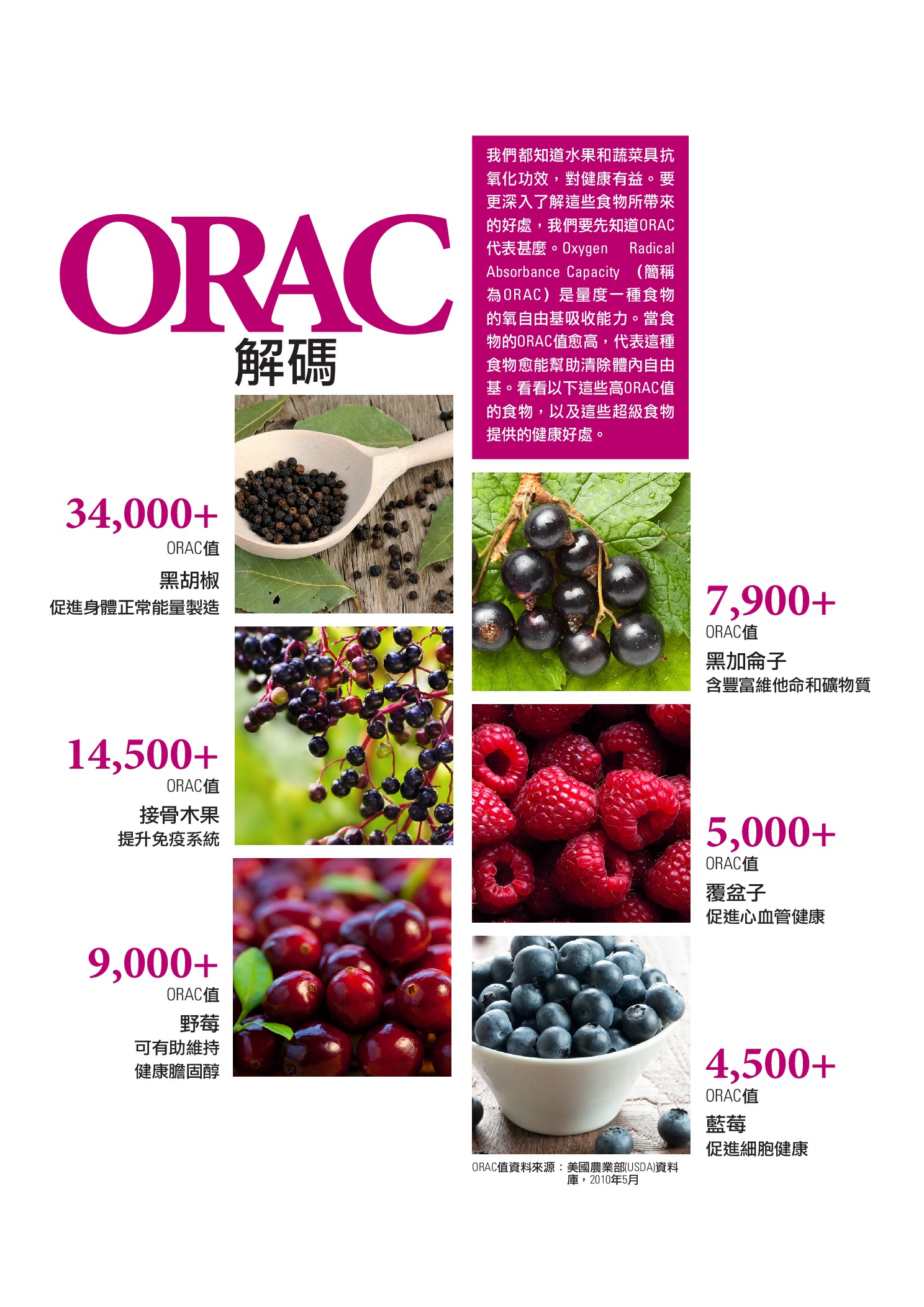
了解更多
Isotonix®輸送系統
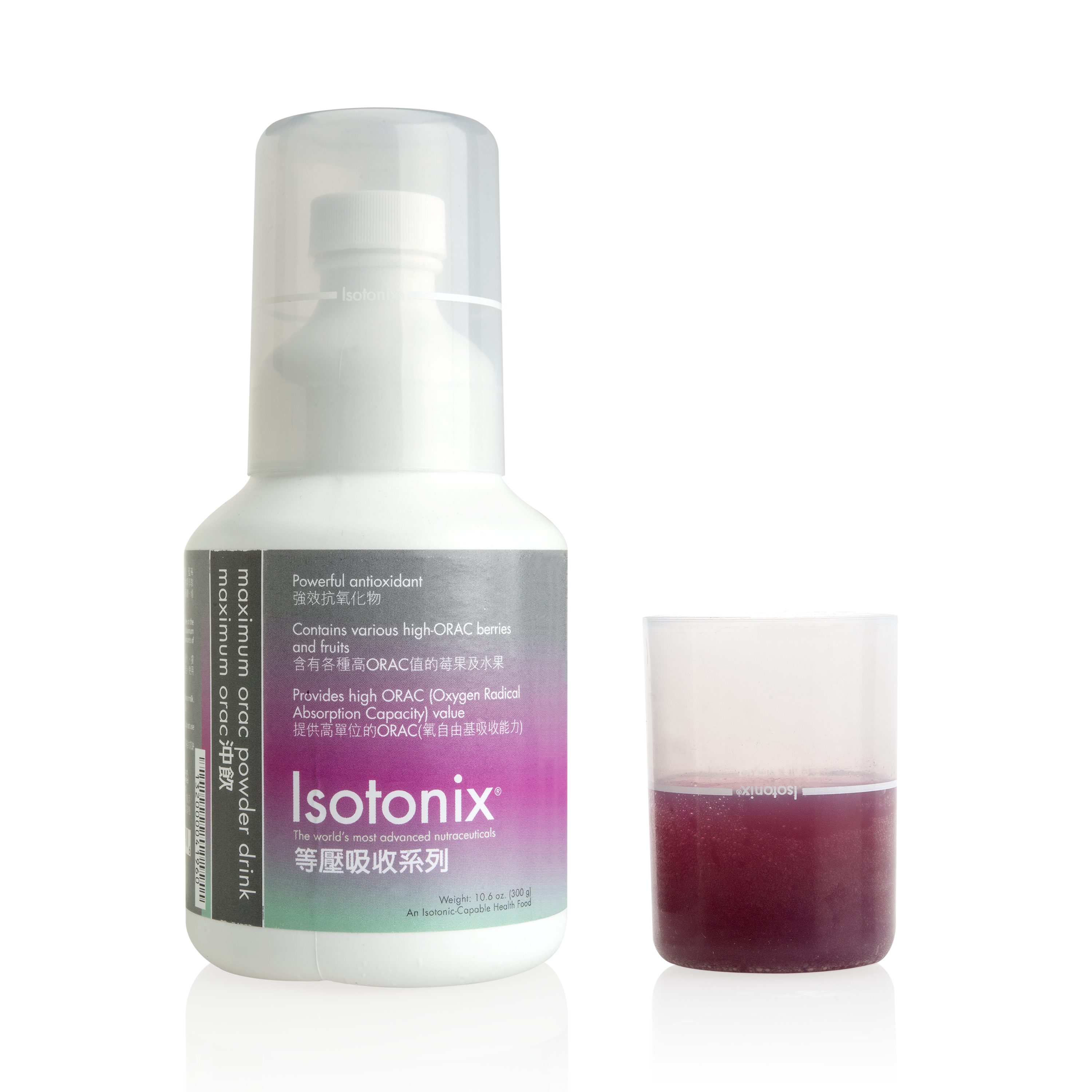
Isotonix系列產品是最有效的輸送營養補充品之一。配方採用先進和經科學證實的成分,提供高效輸送及卓越的效果。
Isotonix為等滲壓的原因是因為產品與人體內的液體相同,含有幾乎相同的濃縮可溶物,如盬、糖及礦物質。在此濃度下,營養及分子便能有效地通過細胞壁,用作細胞代謝。Isotonix產品配方中的果糖、葡萄糖、檸檬酸、碳酸氫鉀及其他主要成分搭配均衡,以確保正確調配飲用時達到等滲狀態。
Isotonix產品以適當的比例與濃度傳送營養素,以達致最佳的吸收。Isotonix是市場上經科學證實最有效的營養傳輸系統之一。
成份
蔓越莓濃縮萃取物 200 亳克
蔓越莓是一種矮小的常綠灌木,會開深粉紅色的花,生長在潮濕的沼澤和山林中。它的花期一般由春季末期至夏季尾聲。而這種灌木的紅色小果實會在秋天結果。這植物的治療特性來自其果實。初步證據顯示,蔓越莓能提高血液中的抗氧化水平,或有助於穩定膽固醇*。蔓越莓含有很高的ORAC值。
藍莓萃取物 100 亳克
在眾多水果及蔬菜中,藍莓的ORAC值排名最高,它含有 25-30 種不同種類的花青素。花青素是強效的類黃酮抗氧化物,令藍莓(及其他水果)具有豐富的藍色和紅色。圍繞花青素運作的原理已在分子水平上進行了研究,並顯示出其促進細胞健康等作用。藍莓提供大量綠原酸,被認為對促進細胞健康相當重要。藍莓支援人體的COX-2抑製劑,提供強效的抗氧化物防禦能力,為身體提供強大而全面的抗氧化防護網。
葡萄汁萃取物 93 亳克
葡萄汁含有多種酚類化合物,包括花青素、肉桂酸及黃烷-3-醇,這些物質均被證實能有效促進心血管健康。花青素是強效的類黃酮抗氧化物,有助於維持細胞健康。初步證據顯示,花青素有助維持健康的微絲血管,這或有助於穩定膽固醇,及整體的心血管健康。*
覆盆梅果萃取物 90 亳克
覆盆梅含有大量的多酚類抗氧化物,及促進內皮和心血管健康的化學物質。覆盆梅含有很高的纖維,是維他命C和錳的優質來源,亦是維他命K及鎂的理想來源,並含有鈣和鐵。覆盆梅是強大的抗氧化物,特別是由於它含豐富的鞣花酸(來自鞣花單寧),檞皮素、沒食子酸、花青素、矢車菊素、天竺葵素、兒茶酚、山奈酚和水楊酸。它們均含有很高的ORAC值。
接骨木果萃取物 40 亳克
接骨木果含有類黃酮蘆丁、異槲皮素、金絲桃苷及必需油份—花青素苷類。一直以來接骨木果被用作製成接骨木酒、接骨木白蘭地,和深受歡迎的珊布卡甜酒。接骨木果具有很高的ORAC值,有助於促進全面的抗氧化防護網及刺激免疫系統。
黑加侖子萃取物 40 亳克
由於黑加侖子的花青素含量很高,令它成為強效的抗氧化物。它們是維他命C的豐富來源,含有高濃度的維他命B雜、維他命A,鉀、鎂、鐵和鈣。黑加侖子具有很高的ORAC值。它們有助於促進全面的抗氧化防護網,刺激免疫系統和促進心血管健康。
石榴萃取物 40 亳克
一個石榴可以提供一個成年人每日所需維他命C的40%,而石榴亦是葉酸及多種抗氧化物的豐富來源。石榴含有大量多酚類,其中最大量的是水解單寧酸,特別是安石榴甙。研究顯示安石榴甙是石榴汁負責對抗自由基的抗氧化物。
很多食品及膳食補充品製造商均發現利用石榴萃取物代替石榴汁有著多種好處,石榴萃取物不含糖份、卡路里或添加劑,是產品的健康成份。大部份石榴萃取物均為鞣花酸,主要為提取石榴汁過程的副產品。很多研究文獻均顯示鞣花酸若以鞣花單寧酸(例如安石榴甙)的形式使用,可以被人體吸收。
梅子果粉 30 亳克
梅子含有多種強效的抗氧化物及高ORAC值。它是多種主要維他命及礦物質的豐富來源。同時亦含有豐富的膳食纖維、山梨糖醇及靛紅。它們普遍使用於促進消化系統健康,亦有助建立全面的抗氧化防護網絡,促進認知能力健康及心血管健康。
山楸梅萃取物 20 亳克
山楸梅含有豐富的花青素,是強效的抗氧化物。它們含有豐富維他命及礦物質,有助促進整體健康。並幫助形成全面的抗氧化防護網,清除自由基。
黑胡椒萃取物 (Bioperine™¥): 56微克
胡椒素是一種從黑胡椒或長胡椒果實中提取出來的標準萃取物。它含有95%的胡椒鹼。人體在細胞水平上產生能量的新陳代謝過程被稱為生熱作用。儘管生熱作用被認為是維持減重的關鍵因素,但同時每天在人體消耗食物和營養過程中擔當著不可缺少的角色。它啟動了導致消化和之後的腸胃道吸收的機制。胡椒鹼是胡椒素的專利形態,能促進人體的自然生熱作用。胡椒素能提升某些營養素(尤其是抗氧化物)的生物可利用性。
¥Bioperine™ 是Sabinsa Corporation的商標。
維他命C(抗壞血酸)︰25 毫克
維他命C存在於椒類(甜椒、青椒、紅椒、紅辣椒及青辣椒)、柑橘類果實、小椰菜、椰菜花、椰菜、羽衣甘藍、綠葉甘藍、芥菜、西蘭花、菠菜、番石榴、奇異果、提子及士多啤梨等。堅果類及穀類亦含有微量的維他命C。要記住重要一點,烹調會破壞維他命C的營養價值。
維他命C支援健康的免疫系統,促進心血管健康,或有助穩定膽固醇*,以及提供抗氧化功能。人體無法自行製造及儲存維他命C。因此,必須透過飲食和營養補充品攝取維他命C。
維他命E(d-alpha 生育酚醋酸酯): 7.5 IU(國際單位)
維他命E是生育醇和生育三烯酚化合物群組的統稱。維他命E重要的膳食來源包括蔬菜油、人造牛油、果仁、種籽、牛油果和小麥胚芽。紅花籽油含豐富的維他命E (¼杯就約相等於⅔的每日建議攝取量),而粟米油和大豆油中僅含有微量維他命E。維他命E可分為天然或合成的形式。大部份情況下,天然和合成形式並沒有分別,但天然的維他命E能更有效被人體吸收及保留。正在節食的人普遍非常關注他們飲食中脂肪的攝取量,然而由於他們減少攝取脂肪含量較高的食物,因此有可能也減少攝取維他命E。維他命E的主要功能在於它能促進免疫功能的抗氧化特性。亦能為心血管系統提供保護作用。維他命E是體內最強效的脂溶性抗氧化物之一。同時能保護細胞膜免受自由基的侵害。維他命C和E的組合有助於形成抗氧化防護網,促進維他命之間的協同運作,令它們從枯竭狀態回復至活性抗氧化狀態,得以繼續中和自由基。
*此產品沒有根據《藥劑業及毒藥條例》或《中醫藥條例》註冊。為此產品作出的任何聲明亦沒有為進行該等註冊而接受評核。此產品無意作為診斷、治療或預防任何疾病之用。
常見問答
甚麼是抗氧化劑?
抗氧化劑的意思就是對抗氧化作用,抗氧化物可保護脂質免受自由基的過氧化侵害。抗氧化物之所以有效,是因為它們會將自己的電子給予自由基。當自由基從抗氧化物得到電子後,便不再需要攻擊人體細胞,氧化作用的連鎖反應便會被終斷。
自由基是從哪裏來的?
簡單如呼吸、食物代謝過程、產生三磷酸腺苷(ATP)促進酶催化反應等,都會產生自由基。自由基的產生源自以下活動︰進食高脂肪食物、加工食物、食物防腐劑、電離輻射(紫外線、伽瑪射線、X光)、運動、壓力、污染、食用水氯氣及吸煙。Maximum ORAC 透過增加血液中的抗氧化物含量、保護我們從飲食中攝取的抗氧化物,並在某些情況下增強其抗氧化活性,以提升身體對抗氧化的能力。
我已經食用含維他命A、C及E的抗氧化補充品,食用等滲壓營養補充品是否效果更佳?
是的。當你攝入食物、飲品或大部份營養補充品時,胃部會分泌稀釋液、酵素、鹽酸、及最少一種結合維他命的蛋白質以開始消化過程。視乎每餐的份量,但此消化過程需時約四十分鐘,所以是同時需要時間及消耗能量。使用等滲壓產品的優勢在於它可將高濃度的營養物直接輸送至小腸。從而大大增加了養份通過細胞膜被吸收的機會。
我們建議你空肚食用Isotonix的產品,如Isotonix Maximum ORAC沖飲,這樣能大大縮短產品在體內的傳輸時間。由於傳輸時間縮短,減少了重要的微量營養素被脂肪、纖維及單寧困在體內,或因高酸性而令微量營養素變得不活躍的機會,導致其營養價值被破壞。溶液流入小腸,與胰腺消化液混合,當中的碳酸氫鈉會中和酸醶值,從而吸收最多的營養。
食用等滲壓配方的營養補充品與傳統片劑補充品有甚麼分別?
在所有類型的口服營養補充品當中,等滲壓溶液是最快及最有效的傳輸方式。溶液中的養份會被快速並高效吸收,不會因滯留在胃部而造成腸胃不適。Isotonix的產品並非膠囊,因此不會像傳統的營養補充品一樣含有填充劑、黏合劑、塗料、潤滑劑、分解劑或人造色素。
O.R.A.C.代表甚麼?
O.R.A.C.代表Oxygen Radical Absorption Capacity,即「氧自由基吸收能力」,用以量度某種物質的抗氧化能力。ORAC 量度某種物質能吸收多少氧自由基,ORAC值越高,代表越能幫助人體清除自由基。
食用Isotonix Maximum ORAC沖飲安全嗎?
此產品安全且不含有害物質、防腐劑及酒精。產品在美國製造,並經由美國食品及藥物管理局檢測及獲得優良藥品製造規範的設備生產。顧客可信賴本產品的質量和安全。
科學
- Cao, G., et al. Oxygen-radical absorbance capacity assay for antioxidants. Free Radical Biology and Medicine. 14: 303-11, 1993.
- Bagchi, D., et al. Anti-angiogenic, antioxidant, and anti-carcinogenic properties of a novel anthocyanin-rich berry extract formula. Biochemistry. 69:95-102, 2004.
- Bagchi, D., et al. Safety and whole-body antioxidant potential of a novel anthocyanin-rich formulation of edible berries. Mol Cell Biochem. 281:197-209, 2006.
- Zheng, W., et al. Oxygen radical absorbing capacity of phenolics in blueberries, cranberries, chokeberries, and lingonberries. J Agric Food Chem. 51:502-9, 2003.
- Cao, G., et al. Increases in human plasma antioxidant capacity after consumption of controlled diets high in fruit and vegetables. Am J Clin Nutr. 68:1081-7, 1998.
- Mazza, G., et al. Absorption of anthocyanins from blueberries and serum antioxidant status in human subjects. J Agric Food Chem. 50:7731-7, 2002.
- Kay, C., et al. The effect of wild blueberry (Vaccinium angustifolium) consumption on postprandial serum antioxidant status in human subjects. Br J Nutr. 88:389-98, 2002.
- Roy, S., et al. Anti-angiogenic property of edible berries. Free Radical Research. 36: 1023-31, 2002.
- Aviram, M., et al. Pomegranate juice consumption reduces oxidative stress, atherogenic modifications to LDL, and platelet aggregation: studies in humans and in atherosclerotic apolipoprotein E-deficient mice. American Journal of Clinical Nutrition. 71:1062-1076, 2000.
- Youdim, K. A., et al. Incorporation of elderberry anthocyanins by endothelial cells increases protection against oxidative stress. Free Radic Biol Medicine. 29:51-60, 2000.
- Packer, L., et al. Molecular aspects of alpha-tocotrienol antioxidant action and cell signalling. Journal of Nutrition. 131:369S-373S, 2001.
- Reed, J. Cranberry flavonoids, atherosclerosis and cardiovascular health. Crit Rev Food Sci Nutr. 42(3 Suppl):301-16, 2002. Review.
- Halvorsen, B., et al. A systematic screening of total antioxidants in dietary plants. J Nutr. 132:461-71, 2002.
- Maatta, K., et al. Phenolic compounds in berries of black, red, green, and white currants (Ribes sp.). Antioxid Redox Signal. 3:981-93, 2001.
- Murkovic, M., et al. Effects of elderberry juice on fasting and postprandial serum lipids and low-density lipoprotein oxidation in healthy volunteers: a randomized, double-blind, placebo-controlled study. Eur J Clin Nutr. 58:244-9, 2004.
- Faria, A., et al. Antioxidant properties of prepared blueberry (Vaccinium myrtillus) extracts. J Agric Food Chem. 53:6896-902, 2005.
- Joseph, J., et al. Reversing the deleterious effects of aging on neuronal communication and behavior: beneficial properties of fruit polyphenolic compounds. Am J Clin Nutr. 81(1 Suppl):313S-316S, 2005. . Review.
- Liu, M., et al. Antioxidant and antiproliferative activities of raspberries. J Agric Food Chem. 50:2926-30, 2002.
- Wang, R., et al. Bioactive compounds from the seeds of Punica granatum (pomegranate). J Nat Prod. 67:2096-8, 2004.
- Youdim, K., et al. Polyphenolics enhance red blood cell resistance to oxidative stress: in vitro and in vivo. Biochim Biophys Acta. 523:117-22, 2000.
- Chun, O., et al. Superoxide radical scavenging activity of the major polyphenols in fresh plums. J Agric Food Chem. 51:8067-72, 2003.
- Stein, J., et al. Purple grape juice improves endothelial function and reduces the susceptibility of LDL cholesterol to oxidation in patients with coronary artery disease. Circulation 100: 1050-5, 1999.
- Kamal-Eldin, A., et al. The chemistry and antioxidant properties of tocopherols and tocotrienols. Lipids. 31: 671-701, 1996.
- Hamilton , I. , et al. Interactions between vitamins C and E in human subjects. British Journal of Nutrition. 84:261-267, 2000.
- Berry , E., et al. Synergism between vitamins E and C: biological implications for future research. Int J Cancer. 83:288, 1999.
- Frei, B., et al. Ascorbate is an outstanding antioxidant in human blood plasma. Proceedings of the National Academy of Sciences USA 86(16):6377-6381, 1989.
- Wilson, T., et al. Cranberry extract inhibits low density lipoprotein oxidation. Life Sciences. 62:381-386, 1998.
- Aviram, M., et al. Pomegranate juice flavonoids inhibit low-density lipoprotein oxidation and cardiovascular diseases: studies in atherosclerotic mice and in humans. Drugs Exp Clin Res. 28:49-62, 2002.
- Esmaillzadeh, A., et al. Concentrated pomegranate juice improves lipid profiles in diabetic patients with hyperlipidemia. J Med Food. 7(3):305-308, 2004.
- Abuja , P., et al. Antioxidant and prooxidant activities of elderberry (Sambucus nigra) in low-density lipoprotein oxidation. J Ag Food Chem. 46:4091-4096, 1998.
- Ruel, G., et al. Changes in plasma antioxidant capacity and oxidized low-density lipoprotein levels in men after short-term cranberry juice consumption. Metabolism. 54:856-61, 2005.
- Chu , Y., et al. Cranberries inhibit LDL oxidation and induce LDL receptor expression in hepatocytes. Life Sci. 77:1892-901, 2005.
- Vuorela, S., et al. Preclinical evaluation of rapeseed, raspberry, and pine bark phenolics for health related effects. J Agric Food Chem. 53:5922-31, 2005.
- Lau, F., et al. The beneficial effects of fruit polyphenols on brain aging. Neurobiol Aging. 26 Suppl 1:128-32, 2005.
- Andres-Lacueva, C., et al. Anthocyanins in aged blueberry-fed rats are found centrally and may enhance memory. Nutr Neurosci. 8:111-20, 2005.
- Galli, R., et al. Blueberry supplemented diet reverses age-related decline in hippocampal HSP70 neuroprotection. Neurobiol Aging. 27:344-50, 2006.
- Casadesus, G., et al. Modulation of hippocampal plasticity and cognitive behavior by short-term blueberry supplementation in aged rats. Nutr Neurosci. 7:309-16, 2004.
- Galli, R., et al. Fruit polyphenolics and brain aging: nutritional interventions targeting age-related neuronal and behavioral deficits. Ann N Y Acad Sci. 959:128-32, 2002. Review.
- Joseph, J., et al. Reversals of age-related declines in neuronal signal transduction, cognitive, and motor behavioral deficits with blueberry, spinach, or strawberry dietary supplementation. J Neurosci. 19:8114-21, 1999.
- Hou, D., et al. Potential mechanisms of cancer chemoprevention by anthocyanins. Curr Mol Med. 3:149-59 2003. Review.
- Weiss, E., et al. Cranberry juice constituents affect influenza virus adhesion and infectivity. Antiviral Res. 66:9-12, 2005.
- Hope Smith, S., et al. Antimutagenic activity of berry extracts. J Med Food. 7:450-5, 2004.
- Monograph. Sambucus nigra (elderberry). Altern Med Rev. 10:51-4, 2005.
- Majeed M., Badmaev, V., and Prakash, L. Bioperine ® . New Jersey : NutriScience Publishers, Inc., 1999.
- Lambert, J., et al. Piperine enhances the bioavailability of the tea polyphenol (-)-epigallocatechin-3-gallate in mice. J Nutr. 134:1948-52, 2004.
- Shoba, G., et al. Influence of piperine on the pharmacokinetics of curcumin in animals and human volunteers. Planta Med. 64:353-6, 1998.
- Badmaev, V., et al. Piperine derived from black pepper increases the plasma levels of coenzyme Q10 following oral supplementation. J Nutr Biochem. 11:109-13, 2000.
- Ames , BN, et al. Oxidants, antioxidants, and the degenerative diseases of aging. Proc Natl Acad Sci USA 90:7915-7922, 1993.
- Bagchi, D, et al. Oxygen free radical scavenging abilities of vitamins C and E, and a grape seed proanthocyanidin extract in vitro. Res Commun Mol Pathol Pharmacol 95:179-89, 1997.
- Bagchi, D, et al. Free radicals and grape seed proanthocyanidin extract: importance in human health and disease prevention. Toxicology 148: 187-97, 2000.
- Bagchi, D, et al. Cellular protection with proanthocyanidins derived from grape seed. Ann NY Acad Sci 957:260-70, 2002.
- Drew B, Leeuwenburgh C. Aging and the role of reactive nitrogen species. Ann NY Acad Sci 959:66-81, 2002.
- Gibson, L, et al. Effectiveness of cranberry juice in preventing urinary tract infections in long-term care facility patients. J Naturopathic Med 2:45-47, 1991.
- Graham DY, Smith JL, Bouvet, AA. What happens to tablets in the stomach. J Pharm Sci 79:420-24, 1990.
- Havsteen B. Flavonoids, a class of natural products of high pharmacological potency. Biochem Pharm 32:1141-48, 1983.
- Halpern, MJ, et al. Red wine polyphenols and inhibition of platelet aggregation: possible mechanisms, and potential use in health promotion and disease prevention. J Int Med Res 26:171-80, 1998.
- Joseph JA, Shukitt-Hale B, Denisova NA, Bielinksi D, Martin A, McEwen JJ, Bickford PC. Reversals of age-related declines in neuronal signal transduction, cognitive, and motor behavioral deficits with blueberry, spinach, or strawberry dietary supplementation. J Neuroscience 19: 8114-21, 1999.
- Kehrer JP. Free radicals as mediators of tissue injury and disease. Crit Rev Toxicol 23:21-48, 1993.
- Koch R. Comparative study of Venostatin and Pycnogenol in chronic venous insufficiency. Phytother Res 16:S1-5, 2002.
- Koparker AD, Augsburger LL, Shangraw RF. Intrinsic dissolution rates of tablet fillers and binders and their influence on the dissolution of drugs from tablet formulations. Pharm Res 7:80-85, 1990.
- Nesaretnam K, et al. Effect of tocotrienols on the growth of a human breast cancer cell line in culture. Lipids 30:1139-43, 1995.
- Ofek I, Goldhar J, Zafriri D, Lis H, Sharon N. Anti-Escherichia coli adhesion activity of cranberry and blueberry juices. New England J Med 324:1599, 1991.
- Qureshi, A, et al. Response of hypercholesterolemic subjects to administration of tocotrienols. Lipids 30:1171-77, 1995.
- Rimbach G, Virgili F, Park YC, Packer L. Effect of procyanidins from Pinus maritime on glutathione levels in endothelial cells challenged by 3-morpholinosydnonimine or activated macrophages. Redox Rep 4:171-77, 1999.
- Sobota AE. Inhibition of bacterial adherence by cranberry juice: potential use for the treatment of urinary tract infactions. J Urology 131:1013-1016, 1984.
- Soloway MS, Smith RA. J Am Med Assoc 260:1465, 1988.
- Tomco, A, et al. Antioxidant effects of tocotrienol in patients with hyperlipidemia and carotid stenosis. Lipids 30: 1179-83, 1995.






